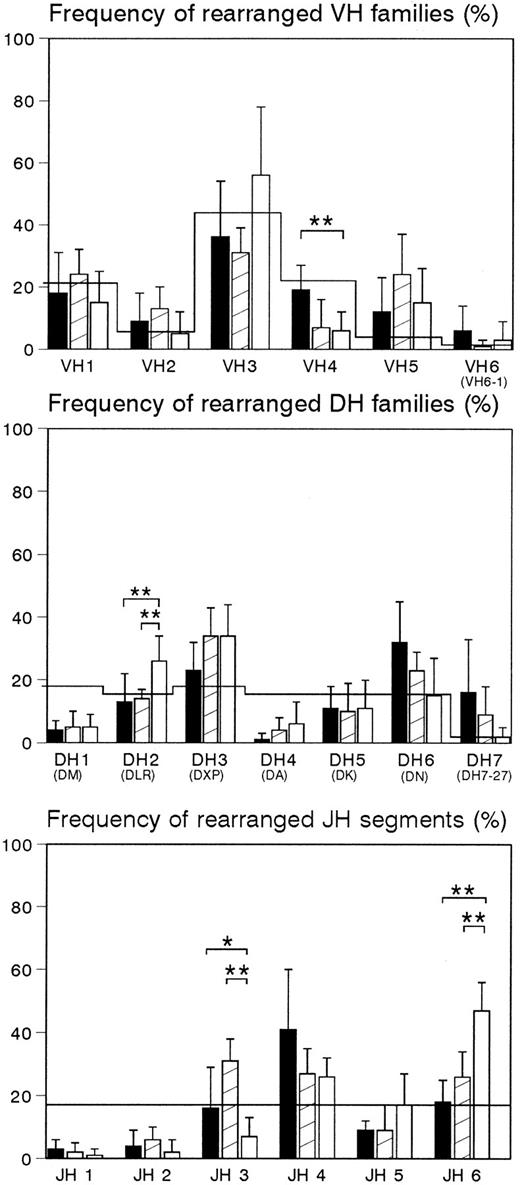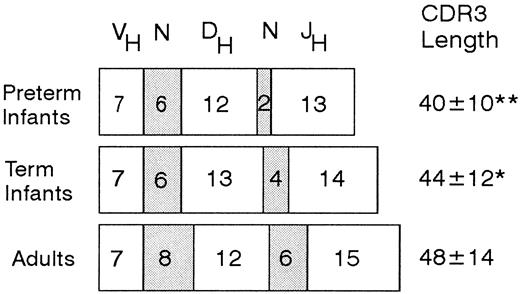The immunoglobulin diversity is restricted in fetal liver B cells. This study examined whether peripheral blood B cells of extremely preterm infants show similar restrictions (overrepresentation of some gene segments, short third complementarity-determining regions [CDR3]). DNA of rearranged immunoglobulin heavy chain genes was amplified by polymerase chain reaction, cloned, and sequenced. A total of 417 sequences were analyzed from 6 preterm infants (25-28 weeks of gestation), 6 term infants, and 6 adults. Gene segments from the entire VHand DH gene locus were rearranged in preterm infants, even though the DH7-27 segment was overrepresented (17% of rearrangements) compared to term infants (7%) and adults (2%). CDR3 was shorter in preterm infants (40 ± 10 nucleotides) than in term infants (44 ± 12) and adults (48 ± 14) (P < .001) due to shorter N regions. Somatic mutations were exclusively found in term neonates and adults (mutational frequency 0.8% and 1.8%). We conclude that preterm infants have no limitations in gene segment usage, whereas the diversity of CDR3 is restricted throughout gestation.
Introduction
The huge variety of immunoglobulin specificities is generated during B-cell development by rearrangements of the variable (VH), diversity (DH), and joining (JH) gene segments (combinatorial diversity), by insertion and deletion of random nucleotides during joining (junctional diversity),1 and by the introduction of somatic mutations.2 In B cells of fetal liver the diversity of rearranged immunoglobulin heavy (IgH) chain variable region genes is restricted by a marked overrepresentation of some VH and DH gene segments3 and by short CDR3.4 It is unknown whether these restrictions are limited to the immature B cells of the fetal liver5 or are also present in peripheral B cells, and if restrictions persist only during the first trimester of pregnancy6 or until early infancy.4
To test the hypothesis that marked restrictions in immunoglobulin diversity persist in preterm infants and throughout gestation, we studied rearranged IgH chain variable region genes of peripheral blood B cells from extremely preterm infants, term infants, and adults.
Study design
Patients
We collected cord blood of 6 preterm infants (25-28 weeks of gestation, birth weight 470-1120 g), 6 term infants (39-42 weeks), and peripheral blood of 6 adults, aged 26 to 43 years. Infections were ruled out in all individuals (normal clinical examination, blood count, and C-reactive protein). The study protocol had been approved by the institutional review board and written consent was obtained.
Amplification and sequencing of VDJ rearrangements
DNA (0.5-1.0 μg) extracted from heparinized blood samples was used for the polymerase chain reaction (PCR) amplification of the rearranged IgH chain variable region with a nested primer PCR previously established by our group.7 8 For the first amplification a mixture of family-specific primers for framework region 1 was used in conjunction with a consensus JH primer; for the reamplification framework region 2 family-specific primers with another consensus JH primer. Positive (B-cell line Raji) and negative (H2O) controls were carried out with each PCR.
The amplificates (length 230-280 nucleotides) were isolated and cloned (TOPO TA cloning kit, Invitrogen, Leek, The Netherlands). Twenty-five to 35 randomly selected clones of each subject were sequenced (ABI 377A, Applied Biosystems, Weiterstadt).
Sequenceanalysis
The germline VH, JH, and DHsegments were identified using GenBank (release 98) and VBASE directory.9,10 Only functional rearrangements were further analyzed. For DH identification we used the criteria of Shiokawa,4 but accepted no DIR segments, inverted D segments, or D-D recombinations.11 CDR3 was defined according to Kabat (amino acids 93-102).12
Results and discussion
This is the first study of the evolution of IgH chain variable region diversity of mature peripheral blood B cells in the last trimester of human gestation. For this purpose we analyzed 417 unrelated functional IgH rearrangements as demonstrated by their unique VH-DH-JH junctions from 6 preterm infants, 138 sequences, GenBank Database accession nos. AF 235505-235642; from 6 term infants, 142 sequences, AF 235643-235784; and from 6 adults,137 sequences, AF 235785-235921. Strengths of our study are that we always studied groups of individuals and that we investigated the same cell population, mature B cells, in each group.
The combinatorial diversity was similar in the 3 groups. All individuals, even each of the most immature preterm infants, used VH, DH, and JH gene segments from the entire gene locus. VH family usage roughly corresponded to VH family size. Only the VH4 family was used significantly more often in preterm infants (P < 0.01) (Figure 1). The number of different VH gene segments used was not smaller in preterm infants (31 VH gene segments), than in term infants (28) or adults (30) and the VH 6-1 gene segment (= VH6 family) was only slightly overrepresented in preterm infants compared to adults (5.5% versus 2.0% of sequences). Each group used 18 of the 27 DH gene segments, even though the DH7-27 segment (= DH7 family) was overrepresented in preterm infants (17% of rearrangements) compared to term infants (7%), and adults (2%) (Figure 1).
Rearranged gene families.
Frequency of rearranged VH gene families, DHgene families, and JH gene segments in preterm infants (filled bars), term infants (hatched bars), and adults (open bars). The VH6 family contains the single gene segment VH6-1, and the DH7 family the single gene segment DH7-27. The line indicates the frequency of usage expected from the germline composition. Values are mean ± SD; **P < .01; *P < .05 (ANOVA).
Rearranged gene families.
Frequency of rearranged VH gene families, DHgene families, and JH gene segments in preterm infants (filled bars), term infants (hatched bars), and adults (open bars). The VH6 family contains the single gene segment VH6-1, and the DH7 family the single gene segment DH7-27. The line indicates the frequency of usage expected from the germline composition. Values are mean ± SD; **P < .01; *P < .05 (ANOVA).
Previous studies described an overrepresentation of the VH6-1 gene segment (25%) and the DH7-27 gene segment (50%) in early fetal liver B cells (8-10 weeks of gestation).3,4 These gene segments are located at the 3′ end of their respective gene locus, which makes them more readily available for recombination. This bias moderately decreased in later stages of gestation (15-19 weeks of gestation).3,4 13Our study demonstrates that the overrepresentation was dramatically reduced in preterm infants (VH6-1: 5.5%; DH7-27: 17%) and did not affect the overall combinatorial diversity any more.
The preterm infants we studied preferentially expressed JH3 and JH4 (Figure 1). This is in agreement with developmental trends observed previously. With increasing age JH usage shifts from the DH proximal JH1/JH2 gene segments in the fetus to JH4/JH6 in adults.4
The mean length of VH rearrangements considerably increased by 4 nucleotides from preterm infants to term infants and by 8 nucleotides from preterm infants to adults (Figure2, P < .001, ANOVA). The paramount cause of this increase was addition of N-nucleotides. This suggests that the activity of the terminal deoxynucleotidyl transferase (TdT), that introduces N-nucleotides, is regulated in close correlation to gestational age. DH length and the contribution of JH to CDR3 were not reduced in the infants, indicating that overrepresentation of DH7-27, the shortest DHgermline segment, and use of shorter JH gene segments,4 to which short CDR3 had been attributed in the fetus, did not affect CDR3 length in infants (Figure 2).
Mean length (nucleotides) of the different components of CDR3 in preterm infants, term infants, and adults.
Data are mean ± SD; **P < .001 versus term infants and versus adults; *P < .05 versus adults (ANOVA).
Mean length (nucleotides) of the different components of CDR3 in preterm infants, term infants, and adults.
Data are mean ± SD; **P < .001 versus term infants and versus adults; *P < .05 versus adults (ANOVA).
Our finding that the CDR3 of preterm infants was 6 N-nucleotides shorter than in adults means a 400-fold reduction in potential CDR3 diversity because the nontemplated N-nucleotides are randomly inserted and therefore each codon added increases the potential diversity of the repertoire 20-fold.14 The short CDR3 has been implicated with the polyreactive low affinity binding of antigen observed in fetus and neonate.3 The short CDR3 in preterm infants might therefore contribute to their increased susceptibility to infection. Yet, the significance of CDR3 length for immunologic competence is not completely understood. Mice with a null mutation in the TdTgene and no N-nucleotides had surprisingly normal immune responses,15 whereas exceptionally long CDR3 regions were found in X-linked agammaglobulinemia4 and nonfunctional IgH chain rearrangements.16
We analyzed all rearrangements for somatic mutations. The nucleotide exchange rate was very low in preterm infants (0.3%) and 75% of the rearrangements were completely identical to the germline. The modifications in preterm infants most likely represent Taq polymerase errors (0.076% in our study) or interindividual polymorphisms or both. Although the overall nucleotide exchange rate was also low in term infants (0.8%), the presence of 15 rearrangements each with more than 3 nucleotide exchanges (range, 4-12 exchanges) clearly indicates their introduction by a somatic mutation mechanism. Moreover, in term infants only 49% of the rearrangements were completely identical to the germline. In blood samples from adults, which were investigated for control and comparison, 38 rearrangements had more than 3 nucleotide exchanges (range, 4-16 exchanges) and thus displayed clear indication for somatic mutations with an overall nucleotide exchange rate of 1.8%. This latter result agrees with previous investigations of blood samples from human adults.16
In conclusion, we demonstrate that there is an unrestricted gene segment usage in preterm as well as in term infants. However CDR3 is significantly shorter in preterm than in term infants or adults. Mutations are absent in preterm infants but are already present at a low frequency in term infants even without prenatal or perinatal infection. Our findings suggest that developmentally regulated limitations in rearranged IgH chain variable regions of neonatal peripheral blood B cells affect junctional diversity and mutational frequency longer than combinatorial diversity.
We thank W. Jekabsons, I. Glaeser, D. Jahnke, H. H. Müller, and H. Lammert for excellent technical assistance.
Supported by Deutsche Forschungsgemeinschaft Grant BA 1187/6-1.
The publication costs of this article were defrayed in part by page charge payment. Therefore, and solely to indicate this fact, this article is hereby marked “advertisement” in accordance with 18 U.S.C. section 1734.
References
Author notes
Karl Bauer, Department of Pediatrics, Universitätsklinikum Benjamin Franklin, Freie Universität Berlin, Hindenburgdamm 30, 12200 Berlin, Germany; e-mail: bauer@medizin.fu-berlin.de.



This feature is available to Subscribers Only
Sign In or Create an Account Close Modal